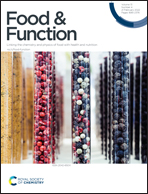Docosahexaenoic acid lessens hepatic lipid accumulation and inflammation via the AMP-activated protein kinase and endoplasmic reticulum stress signaling pathways in grass carp (Ctenopharyngodon idella)
Abstract
The liver is the primary organ for frontline immune defense and lipid metabolism. Excessive lipid accumulation in the liver severely affects its metabolic homeostasis and causes metabolic diseases. Docosahexaenoic acid (DHA) is known for its beneficial effects on lipid metabolism and anti-inflammation, but its molecular mechanism remains unknown, especially in fish. In this study, we evaluated the protective effects of DHA on hepatic steatosis of grass carp (Ctenopharyngodon idella) in vivo and in vitro and mainly focused on the AMP-activated protein kinase (AMPK) and endoplasmic reticulum stress (ER stress) signaling pathway analysis. Grass carp were fed with purified diets supplemented with 0%, 0.5% and 1% DHA for 8 weeks in vivo. 1% DHA supplementation significantly decreased the liver triglyceride (TG), malondialdehyde (MDA), serum tumor necrosis factor α (TNFα) and nuclear factor kappa B (NFκB) contents. DHA administration suppressed ER stress and decreased the mRNA expressions related to hepatic inflammation and lipogenesis, accompanied by the activation of AMPK. Correspondingly, DHA activated the AMPK signaling pathway, and inhibited palmitic acid (PA)-evoked ER stress and lipid accumulation and inflammation of grass carp hepatocytes in vitro. In contrast, the inhibitor of AMPK (compound C, CC) abrogated the effects of DHA to improve PA-induced liver injury and ER stress. In conclusion, DHA inhibits ER stress in hepatocytes by the activation of AMPK and exerts protective effects on hepatic steatosis in terms of improving antioxidant ability, relieving hepatic inflammation and inhibiting hepatic lipogenesis. Our findings give a theoretical foundation for further elucidation of the beneficial role of DHA in vertebrates.



 Please wait while we load your content...
Please wait while we load your content...